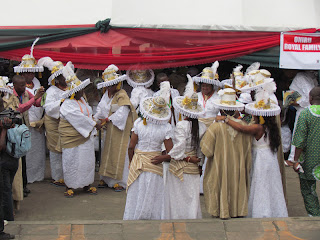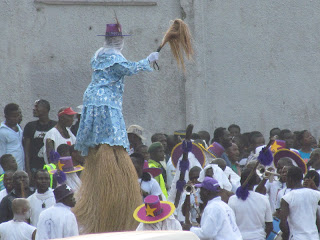 In November these large effigies started appearing around the streets of Lagos, offering a signal that the Eyo Festival would soon take place.
In November these large effigies started appearing around the streets of Lagos, offering a signal that the Eyo Festival would soon take place. This signature masquerade of Lagos Island originated in 1852. It doesn't occur on a regular basis -- it was last held in 2009, but the time before that was in 2003. This is the 83rd occasion of the Eyo play. It is held in memory of an important person from Lagos Island who made a significant contribution to the community during his life. The festival is kind of a funeral rite, but often recognizes someone who passed away a long time ago. This 83rd Eyo play honored the late Chief Yesufu Abiodun Oniru, who reigned from 1934-1984 -- a 50 year rule! The program said that he was born in 1864, which made him 120 when he died! I don't know if his birth date is authenticated, but everyone agrees that he was very long lived.
The Eyo masquerade historically took place on the streets, ending in an open area. When it was performed in 2009, the decision was made to move the play to the large Tafewa Balewa Square, so more people could watch the spectacle in a more secure environment. Though we were in Lagos at that time, we were advised by our company security to stay away from the festival, as they were worried about our safety on the streets. I had friends attend then and they had no problems, and so I jumped at the chance to attend this time, especially after a friend from African Book Group, who is on the organizing committee, got us tickets in the VIP seated area. I'm so glad I had the chance to experience the Eyo festival, as it is such an interesting peek into the culture of traditional Lagos Island. This time we didn't even ask the company security people about going, as I didn't want them to warn us against it, we just made plans to attend. There were a couple of moments entering and leaving the stadium when we worried about our safety, but most of the time we were up high above the action in comfortable, covered seating, with waiters bringing us food and drink. We also got a gift bag with a historical book and program to the festival, a souvenir polo shirt and DVD with a documentary history of the festival.
But the Eyos I met at first were anxious to pose for pictures and glad that oyibos were coming to experience the festival.
This a little child Eyo dressed up for the occasion.
Inside the stadium we were seated opposite the seating of the royal Oniru family, relatives of the honoree. They were dressed for the occasion, many with matching outfits. I'm sure it was very special for them to see their relative so honored.
They did a lot of posing for pictures.
In preparation for this event, someone had designed fabrics for the occasion with the name and picture of Chief Oniru. There was a great variety of clothing for men and women made out of this fabric.
Events that were part of the festival had taken place over the prior few days, but we were there for the final culmination of the festival with the arrival of the Eyo groups in the square.
We did a lot of people watching and visiting with friends. Here's some of my book group friends in the stands. In front is Aduke, who got us the VIP seats. Many thanks, Aduke!
The action itself wasn't anything super exciting, but a long parade as the Eyos arrived and processed in with music and dancing. There were lots of groups with different looks and colorful touches.
There was a great stir with the arrival of the Oba (traditional ruler) of Lagos: His Royal Majesty Oba Rilwanu Osuolala Babatunde Aremu Akolu I. He arrived in a motorcade and in the photo you see the umbrella out ready to cover him as he leaves the car. The umbrella is a symbol of respect for the chief. The photographers were crowding around to record his arrival.
The Eyo figures are known for their high leaping. I had thought it was pretty amazing that they could jump high with their long draping robes. I didn't witness any super high leaps as I had seen previously in pictures, but here's a video with some jumping.
This guy on stilts was pretty talented.
After the "ordinary" Eyo groups processed into the stadium, it was announced that the more prestigious groups, the Orisha groups, would come in and, as a sign of respect, no photography would be allowed. It was pretty amazing to me that, as predatory as photographers can be in this country, they did actually put down their cameras. I put my camera down around my neck, but people motioned me to put it away in my bag. I saw several people get into trouble when they made motions toward their camera. So the most interesting part of the program I couldn't capture with photos. They carried in an enclosure made from mats, called a Para, which holds a symbolic corpse of the honoree. He was lying in state for several days prior to the festival and is paraded in with the Orisha groups.
The governor of Lagos State, Governor Fashola walked into the stadium (in contrast to the long motorcade used by Oba), wearing a white robe and the traditional hat, called an Aga, and he addressed the crowd.
When we left the stadium, we were met by a musical group, who played for us, undoubtedly expecting some monetary reward. They were disappointed, as we had purposely not brought any cash with us that day.
We passed many Eyo groups who had left and were partying in the streets. Most were polite and willing to pose for a picture. Even though I had removed my shoes and was showing, I thought, the proper respect, I did get a pretty sound swat on my back from one of the Eyos. I think he was taking advantage of the opportunity to hit the oyibo. But I got more blessings than hits from the Opumbata that day. The hit I received didn't really leave a bruise, but cemented a solid memory of our day at the Eyo Festival. It was something I will never forget!











































1 comment:
I WISH THAT I COULD'VE HAVE ATTENDED THIS....
Post a Comment